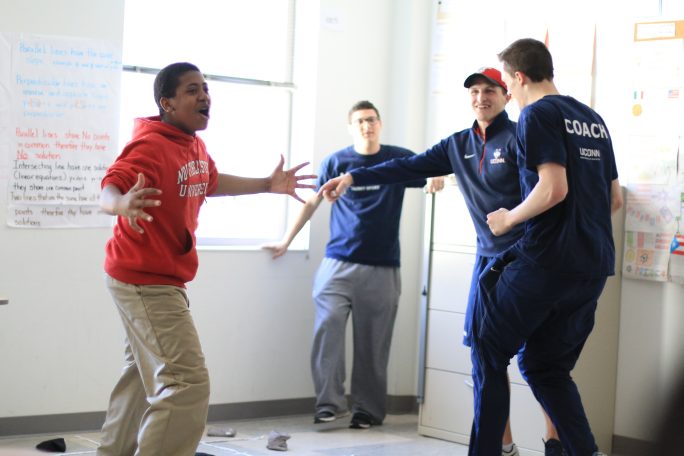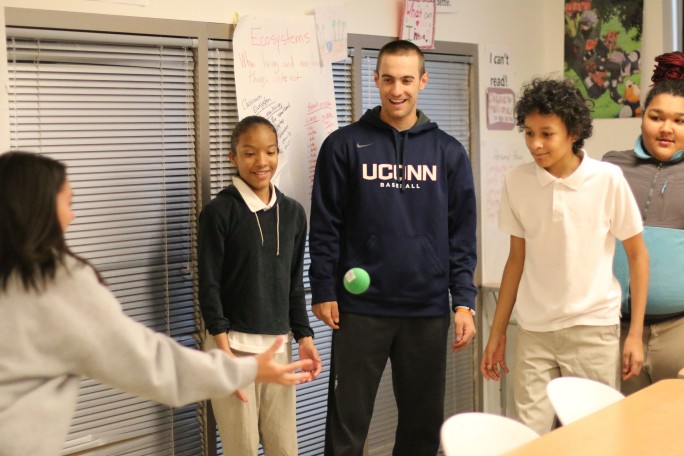Husky Move engages students during school time hours in “Brainergizers” so to facilitate increased student and teacher engagement in fun small group physical activities. This physical literacy intervention aims to model and engage students in learning and practices that will increase awareness of body and motor skills that prevent youth injuries, while also enhancing student confidence and ability to participate in physical activities as part of their daily lives. Curriculum is planned, delivered, and assessed on four key areas of injury prevention;
- Balance
- Strength
- Plyometrics
- Agility
Intervention classes participate in 15-20 minute visits with Husky Move three times a week and have access to a range of workout videos, exercises, and games that allow teachers to integrate additional physical activity sessions outside of the Husky Move partnership.
Working in partnership with faculty and graduate student leaders in the Kinesiology Department, identified needs, program aims, and evaluation continue to drive participation in local and national initiatives to increase youth injury prevention and physical literacy.
Identified Needs: Youth participation in physical activity is critical for preventing obesity, extending life expectancy, and improving quality of life. Keeping children active provides innumerable benefits that include a direct preventative approach to the $150-$200 billion direct medical and reduced productivity costs associated with obesity and diabetes in adults. (1, 2)
Competency in fundamental movement skills (FMS) (i.e. running, hopping, jumping, balancing) is positively associated with increased physical activity levels and inversely associated with weight status in children. (3) However, vast numbers of children lack this competency upon entering adolescence especially in low resourced communities, such as those that participate in Husky Sport programs. (4) The highest obesity rates are found among non-Hispanic Black and Latino children in CTs urban centers, exceeding both state and national averages. (5, 6)
Specific Aims: 1) To evaluate the effects of Husky Move on FMS performance, neuromuscular injury risk factors, measures of obesity (BMI percentile & % body fat), and physical activity monitoring during the school day in children from low resourced communities compared to an active control group. 2) To evaluate the effectiveness of the integration of Husky Move into Husky Sport initiatives to expand knowledge and change attitudes regarding physical activity.
Program Evaluation: We will perform valid and reliable assessments to evaluate BMI percentile, % body fat, FMS performance (Test of Gross Motor Development 2), balance (Balance Error Scoring System), and landing technique (Landing Error Scoring System) four times during the academic school year. Participants and staff will also inform lesson plans and activities through process and formal feedback (check-ins, surveys, focus groups).
References
- Finkelstein EA, Trogdon JG, Cohen JW, Dietz W. Annual medical spending attributable to obesity: payer-and service-specific estimates. Health Aff (Millwood). 2009;28(5):w822-31.
- American Diabetes Association. Economic Costs of Diabetes in the United States. Diabetes Care. 2013;36(4):1033-46.
- Lubans DR, Morgan PJ, Cliff DP, Barnett LM, Okely AD. Fundamental movement skills in children and adolescents: review of associated health benefits. Sports Med. 2010;40(12):1019-35.
- Hardy L, King L, Espinel P, Cosgrove C, Bauman A. NSW Schools in Physical Activity and Nutrition Survey 2010: Full Report. Sydney, Australia: NSW Ministry of Health; 2010.
- Latino Policy Institute. A Profile of Latino Health in Connecticut: The Case for Change in Policy & Practice. 2006.
- CT Department of Public Health. 2011 Connecticut School Health Survey Youth Behavior Component. Hartford, CT; 2012 Retrieved 5/17/2013.



